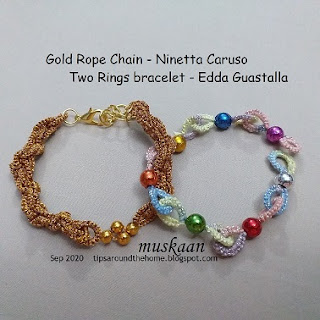Too clever by half! Definitely not. They are truly two very clever tatters, teachers, designers and keep inspiring us with their creativity - Ninetta Caruso and Edda Guastalla!
Ninetta Caruso's Gold Rope Chain - my Rose Gold version
For my interlocking split ring and rope chain pictorials, I had used thick thread. Further, in order to avoid a bare thread spanning the side of each ring, I left the bare thread space shorter than required. Both factors created a gentle spiral, not the rope chain effect in Ninetta's original. I Had to satisfy my scientific curiosity, hence a quick tat with metallic thread.
TIP : The length of bare threads between successive rings determines the amount of twist; and the visible effect can range from a gentle wave to a tight woven rope.
Stringing beads on 3 strands of Anchor metallic embroidery thread that kept splitting was taking too much time. Hence no seed beads.
Much happier with the twisted effect, though could've been better. These are certainly addictive and I stopped only when the shuttles ran out. My fear about the thread were unfounded - the rings closed easily - and only 1 or 2 strands could have worked smoothly as well.
Edda Guastalla's Two Rings (Interlocking) Bracelet/Chain (catenella 2 anelli)
I was very impressed with Edda Guastalla's easy interlocking rings! Such fun, too, besides being practical....
TIP : These twin rings can be used effectively as connectors! Remember these curled ring connectors (CRCs) which are essentially the same twin rings curled around motifs to link them? Instead of curling the rings, one can simply insert thread to make the twin rings.
Two lovely addictive interlocking rings! Vastly different in execution and skills, yet brilliant in conception and creativity. Many many thank to both ladies.
A team that revolutionised the scientific and medical world comprised James Watson and Francis Crick when they unraveled the DNA structure based on Maurice Wilkins' results. Of the 3, the former 2 are more commonly credited.
Francis Crick. Discoverer of the Genetic Code by Matt RidleyNinetta Caruso's Gold Rope Chain - my Rose Gold version
TIP : The length of bare threads between successive rings determines the amount of twist; and the visible effect can range from a gentle wave to a tight woven rope.
Stringing beads on 3 strands of Anchor metallic embroidery thread that kept splitting was taking too much time. Hence no seed beads.
Much happier with the twisted effect, though could've been better. These are certainly addictive and I stopped only when the shuttles ran out. My fear about the thread were unfounded - the rings closed easily - and only 1 or 2 strands could have worked smoothly as well.
Edda Guastalla's Two Rings (Interlocking) Bracelet/Chain (catenella 2 anelli)
I was very impressed with Edda Guastalla's easy interlocking rings! Such fun, too, besides being practical....
- no need to string beads, except the one (or more between the twin rings).
- can use up leftover thread lengths to empty shuttles
- no need to hide tail ends
- only one shuttle required
- easy travel or 'handbag' tatting project
- several variations possible - colour, size, symmetry, etc.
- TIP : eg. One can create a diamond shape instead of simple straight chain. Start with twin rings, then make 2 sets of twin rings within the same (these could have an asymmetric stitch count to move the edges further apart), and a 4th set within both 2nd & 3rd sets to bring them together again.
Red Rose metallic thread size 20. Used up several leftovers that were at least up to 25" long.
The rope chain reminded me of the double helix structure (closer to the quaternary structure) which led me to these books ...
This paperback is a 2008 Harper Perennial edition of the original 2006. It is a rare insight into the life, work and thoughts of Crick. An engaging read, as are most of Ridley's books.
A Passion for DNA. Genes, Genome, and Society by James D Watson
2000, Oxford University Press. This paperback, with high quality paper, is a collection of Watson's lectures, essays, commentaries on diverse topics and the wider impact and implications of the discovery.
Having already read Craig Venter's autobiography, it was interesting to compare notes from both perspectives.
I found Watson was the more conventional and conservative one compared to Crick, though I admired the latter's principles and highly intelligent mind.
Rummaging for all these books brings bittersweet memories - the happy hours spent reading and discussing (hubby & I love Genetics!), but the sadness that I cannot now recall all details. A poor memory that needs huge refreshers ;-D










Beautiful bracelets!
ReplyDeleteThanks to you and Edda, Nin 😃💖💕
DeleteGreat bracelets!! :)
ReplyDeleteThanks, Sue :-)))
DeleteExciting projects!
ReplyDeleteThanks, Anita 💗💕
Delete